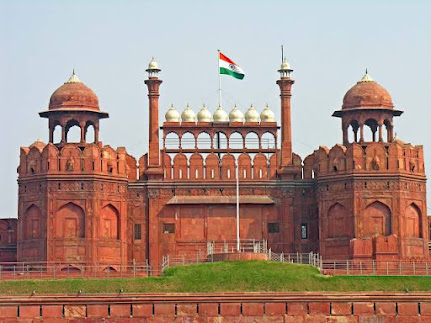3. The Red Fort , New Delhi
The Red Fort is a historic fort in the city of Delhi (in Old Delhi) in India that served as the main residence of the Mughal Emperors. Emperor Shah Jahan commissioned construction of the Red Fort on 12 May 1638, when he decided to shift his capital from Agra to Delhi. Originally red and white, its painting is credited to architect Ustad Ahmad Lahori, who also constructed the Taj Mahal. It was renovated between May 1639 and April 1648 based on an earlier fort.
On 15 August 1947, the first prime minister of India, Jawaharlal Nehru, raised the Indian national flag above the Lahori Gate.[1] Every year on India's Independence Day (15 August), the prime minister hoists the Indian tricolour flag at the fort's main gate and delivers a nationally broadcast speech from its ramparts.
The name Red Fort is a translation of the Hindustani Lal Qila , deriving from its red sandstone walls. Lal was derived from Hindustani language meaning "Red" and Qalah derived from Persian word meaning "Fortress". As the residence of the imperial family, the fort was originally known as the "Blessed Fort", Agra Fort is also known as Lal Qila.
Constructed in 1639 by the fifth Mughal Emperor Shah Jahan as the palace of his fortified capital Shahjahanabad, the Red Fort is named for its massive enclosing walls of red sandstone. The imperial apartments consist of a row of pavilions, connected by a water channel known as the Stream of Paradise (Nahr-i-Bihisht). The fort complex is "considered to represent the zenith of Mughal creativity under Shah Jahan", and although the palace was planned according to Islamic prototypes, each pavilion contains architectural elements typical of Mughal buildings that reflect a fusion of Persian, Timurid and Hindu traditions. The Red Fort's innovative architectural style, including its garden design, influenced later buildings and gardens in Delhi, Rajasthan, Punjab, Kashmir, Braj, Rohilkhand and elsewhere.
The fort was plundered of its artwork and jewels during Nadir Shah's invasion of the Mughal Empire in 1747. Most of the fort's precious marble structures were subsequently destroyed by the British following the Revolt of 1857.[10] The fort's defensive walls were largely spared, and the fortress was subsequently used as a garrison.[10] It was designated a UNESCO World Heritage Site in 2007 as part of the Red Fort Complex.[9][11]
Emperor Shah Jahan commissioned construction of the Red Fort on 12 May 1638, when he decided to shift his capital from Agra to Delhi. Originally red and white, Shah Jahan's favourite colours,its design is credited to architect Ustad Ahmad Lahori, who also constructed the Taj Mahal. The fort lies along the Yamuna River, which fed the moats surrounding most of the walls. Construction began in the sacred month of Muharram, on 13 May 1638. Supervised by Shah Jahan, it was completed on 6 April 1648. Unlike other Mughal forts, the Red Fort's boundary walls are asymmetrical to contain the older Salimgarh Fort. The fortress-palace was a focal point of the city of Shahjahanabad, which is present-day Old Delhi. Shah Jahan's successor, Aurangzeb, added the Pearl Mosque to the emperor's private quarters, constructing barbicans in front of the two main gates to make the entrance to the palace more circuitous.
The administrative and fiscal structure of the Mughal dynasty declined after Aurangzeb, and the 18th century saw a degeneration of the palace. When Jahandar Shah took over the Red Fort in 1712, it had been without an emperor for 30 years. Within a year of beginning his rule, Shah was murdered and replaced by Farrukhsiyar. Muhammad Shah, known as 'Rangila' (the Colourful) for his interest in art. In 1739, Persian emperor Nadir Shah easily defeated the Mughal army, plundering the Red Fort, including the Peacock Throne. Nadir Shah returned to Persia after three months, leaving a destroyed city and a weakened Mughal empire to Muhammad Shah.The internal weakness of the Mughal Empire made the Mughals only titular rulers of Delhi, and a 1752 treaty made the Marathas protectors of the throne at Delhi.The 1758 Maratha victory at Sirhind aided by the Sikhs and successive defeat at Panipat placed them in further conflict with Ahmad Shah Durrani.
Padshah Sultan Ul Quam Nawab Jassa Singh Ahluwalia marching into Red Fort unfurling Nishan Sahibs.
In 1760, the Marathas removed and melted the silver ceiling of the Diwan-i-Khas to raise funds for the defence of Delhi from the armies of Ahmed Shah Durrani. In 1761, after the Marathas lost the third battle of Panipat, Delhi was raided by Ahmed Shah Durrani. Ten years later, the Marathas captured Delhi from the Afghans under the leadership of Mahadji Scindia and Peshwa Madhavrao and placed their puppet emperor Shah Alam II on the throne.





Comments
Post a Comment